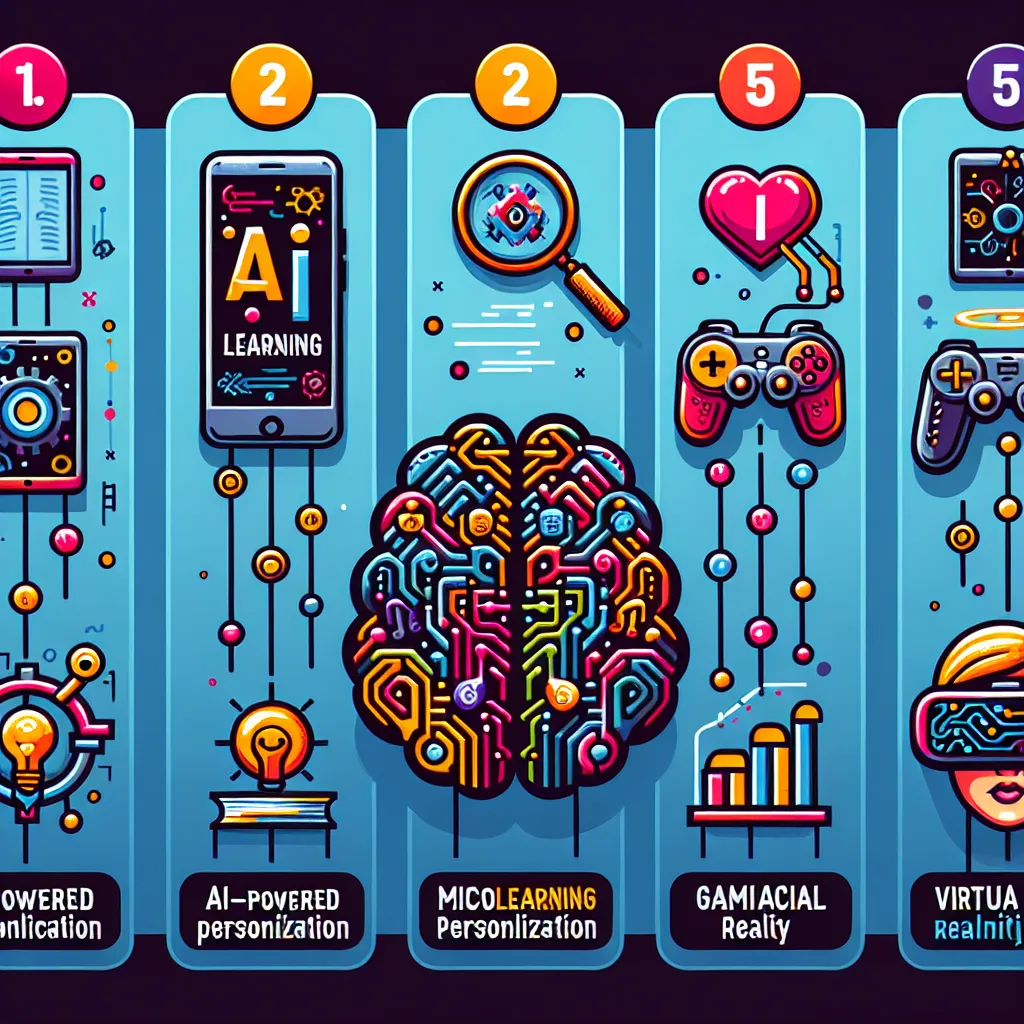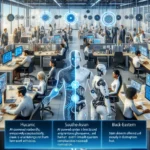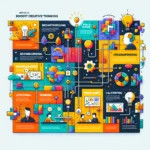The IELTS Reading section challenges test-takers to demonstrate their comprehension skills across a variety of topics. One increasingly prevalent subject in recent years has been e-learning and its impact on education. Based on analysis of past IELTS exams and current educational trends, it’s highly likely that passages related to online learning will continue to appear in future tests. Let’s explore this topic through a practice reading exercise focused on the top trends in e-learning.
 E-learning trends infographic
E-learning trends infographic
Reading Passage: The Future of Learning – Top Trends in E-Learning
Medium Text
The landscape of education is rapidly evolving, with e-learning at the forefront of this transformation. As technology continues to advance, new trends are emerging that are reshaping how we learn and acquire knowledge. This article explores five key trends that are currently dominating the e-learning sphere and are likely to shape its future.
- Mobile Learning
The ubiquity of smartphones and tablets has made mobile learning, or m-learning, one of the most significant trends in e-learning. This approach allows learners to access educational content anytime, anywhere, making learning more flexible and accessible. Mobile learning apps and responsive design for educational websites ensure that learners can engage with content seamlessly across devices. This trend is particularly appealing to younger generations who are accustomed to using mobile devices in their daily lives.
- Artificial Intelligence and Personalization
Artificial Intelligence (AI) is revolutionizing e-learning by enabling personalized learning experiences. AI algorithms can analyze a learner’s performance, preferences, and learning style to create tailored content and learning paths. This level of personalization helps to address individual needs and learning gaps, potentially improving retention and overall educational outcomes. AI-powered chatbots and virtual tutors are also becoming more common, providing instant support and guidance to learners.
- Microlearning
In response to decreasing attention spans and the need for quick, targeted learning, microlearning has gained significant traction. This approach breaks down complex topics into bite-sized, easily digestible chunks of information. Typically lasting between 3-5 minutes, microlearning modules are designed to deliver specific learning objectives efficiently. This format is particularly effective for just-in-time learning and is often used in corporate training environments.
- Gamification
Gamification involves incorporating game-like elements into e-learning experiences to increase engagement and motivation. This can include point systems, leaderboards, badges, and interactive challenges. By tapping into the natural human desire for competition and achievement, gamified learning can make educational content more enjoyable and memorable. This approach has shown particular success in language learning apps and professional development courses.
- Virtual and Augmented Reality
Virtual Reality (VR) and Augmented Reality (AR) are pushing the boundaries of immersive learning experiences. These technologies allow learners to interact with 3D environments and simulations, providing hands-on experience in a safe, controlled setting. VR and AR are particularly valuable in fields such as medicine, engineering, and vocational training, where practical experience is crucial. As the technology becomes more accessible and affordable, its adoption in e-learning is expected to grow significantly.
While these trends are currently at the forefront of e-learning innovation, the field continues to evolve rapidly. Educators and learners alike must stay informed about these developments to harness the full potential of e-learning in both academic and professional contexts. As technology advances, the future of e-learning promises even more personalized, engaging, and effective educational experiences.
Questions
Multiple Choice
-
According to the passage, which of the following is NOT mentioned as a key trend in e-learning?
A) Mobile learning
B) Virtual reality
C) Social media integration
D) Artificial intelligence -
What is the main advantage of microlearning?
A) It uses advanced technology
B) It provides comprehensive coverage of topics
C) It delivers specific learning objectives efficiently
D) It requires sophisticated equipment -
Which trend is described as particularly valuable for fields requiring practical experience?
A) Gamification
B) Microlearning
C) Virtual and Augmented Reality
D) Mobile learning
True/False/Not Given
- Mobile learning is most popular among older generations.
- AI-powered personalization can help address individual learning needs.
- Gamification in e-learning always involves complex video game-like experiences.
- The cost of Virtual Reality technology is a barrier to its widespread adoption in e-learning.
Matching Headings
Match the following headings to the appropriate paragraphs in the passage:
A) Learning on the Go
B) Bite-sized Knowledge Acquisition
C) Immersive Learning Experiences
D) Tailored Learning through Technology
E) Making Education Fun and Competitive
- Paragraph 1: ____
- Paragraph 2: ____
- Paragraph 3: ____
- Paragraph 4: ____
- Paragraph 5: ____
Answer Key and Explanations
-
C
Explanation: The passage mentions mobile learning, virtual reality, AI, microlearning, and gamification, but does not discuss social media integration as a key trend. -
C
Explanation: The passage states that microlearning modules are “designed to deliver specific learning objectives efficiently.” -
C
Explanation: The text mentions that VR and AR are “particularly valuable in fields such as medicine, engineering, and vocational training, where practical experience is crucial.” -
False
Explanation: The passage states that mobile learning is “particularly appealing to younger generations.” -
True
Explanation: The text mentions that AI-powered personalization “helps to address individual needs and learning gaps.” -
Not Given
Explanation: While gamification is described as incorporating game-like elements, the complexity of these elements is not specified. -
Not Given
Explanation: The passage mentions that VR technology is becoming more accessible and affordable but does not explicitly state that cost is a barrier to widespread adoption. -
A
-
D
-
B
-
E
-
C
Common Mistakes and Tips
- Misreading or overlooking key words in questions
- Failing to distinguish between explicitly stated information and inferences
- Not managing time effectively, spending too long on difficult questions
Vocabulary
- Ubiquity (noun) /juːˈbɪkwəti/ – the state of being everywhere
- Personalization (noun) /ˌpɜːsənəlaɪˈzeɪʃən/ – the action of designing or producing something to meet someone’s individual requirements
- Retention (noun) /rɪˈtenʃən/ – the continued possession, use, or control of something
- Traction (noun) /ˈtrækʃən/ – the extent to which an idea, product, etc. gains popularity or acceptance
- Immersive (adjective) /ɪˈmɜːsɪv/ – providing, involving, or characterized by deep absorption or immersion in something
Grammar Focus
Passive Voice: The passive voice is frequently used in academic writing to emphasize the action rather than the actor. For example:
“AI algorithms can analyze a learner’s performance” (active)
“A learner’s performance can be analyzed by AI algorithms” (passive)
Practice forming passive sentences with different tenses to improve your ability to understand and use this structure in academic contexts.
Tips for Success in IELTS Reading
- Practice active reading techniques, such as skimming and scanning.
- Improve your vocabulary, especially in common academic and technical fields.
- Time yourself when practicing to improve your speed and efficiency.
- Pay close attention to transition words and phrases that indicate relationships between ideas.
- Read widely on various topics to build your general knowledge and reading comprehension skills.
By focusing on these areas and regularly practicing with passages like the one above, you can significantly improve your performance in the IELTS Reading section. Remember, consistency and targeted practice are key to achieving a high score.
For more tips on improving your online learning skills, which can also benefit your IELTS preparation, check out our guide on best practices for online learning success. Additionally, developing self-discipline is crucial for effective e-learning and IELTS preparation alike.


